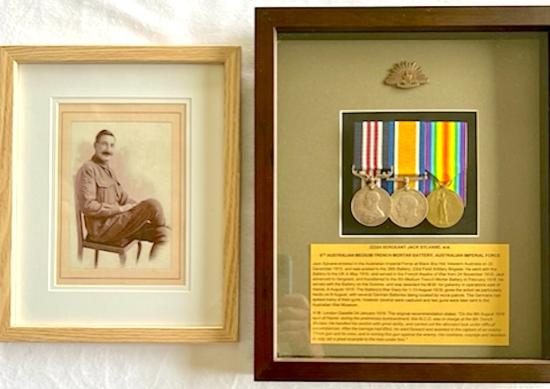WW1 AUSTRALIAN MILITARY MEDAL GROUPING TO SERGEANT JACK SYLVANE
1918 "Somme" Military Medal and Pair to 22286 Sergeant Jack Sylvane MM, 6th Australian Medium Trench Mortar Battery, Australian Imperial Force.
Military Medal. G.V.R. (22286 Sgt: J. Sylvane. 3/Div: -M-Aus. T. M. By:); British War Medal 1914-20 (22286 Sgt. J. Sylvane. 3-D.A.C. A.I.F.); Victory Medal unnamed. Good very fine.
M.M. London Gazette 24 January 1919. The original recommendation states: "On the 8th of August 1918 east of Hamel, during the preliminary bombardment, this N.C.O. was in charge of the 6th Trench Mortars. He handled his section with great ability, and carried out the allocated task under difficult circumstances. After the barrage had lifted, he went forward and assisted in the capture of an enemy 77mm gun and it's crew, and in turning this gun against the enemy. His coolness, courage and devotion to duty set a great example to the men under him."
Sylvane enlisted in the Australian Imperial Force at Black Boy Hill, Western Australia on 20 December 1915, and was posted to the 36th Battery, 23rd Field Artillery Brigade. He went with the Battery to the UK in May 1916, and served in the French theatre of War from 24 November 1916. Sylvane advanced to Sergeant and transferred to the 6th Medium Trench Mortar Battery in February 1918. He served with the
Battery on the Somme and was awarded his M.M. for gallantry in operations east of Hamel, 8 August 1918.
The Battery's War Diary for 1-13 August 1918, gives the action as particularly hectic on 8 August, with several German Batteries being located by recce patrols. The Germans had spiked many of their guns, however several were captured, and two guns were later sent to the Australian War Museum. The Diary also contains the following Citation for Sylvane's M.M; "For devotion to duty, courage and initiative in the advance east of Hamel 8 August 1918. In the initial attack he kept Mortars firing under heavy enemy barrage and in the day dealing with enemy strong points."
Sylvane returned to Australia in H.M.A.T. Somali, 10 December 1918, and was discharged 15 March 1919. Jack's real name was William Innes Smith and he swapped identity with Jack Sylvane as he was over age. He was born in Stepney, London about 1870. Father, William Smith, Master Mariner and Mother, Catherine Elizabeth Innes. His Mother was Anglo/Burmese and his parents were married in Moulmein, Burma. Her father was a Scottish Shipbuilder and his wife a Burmese woman. William Smith (Jack Sylvane) arrived in Freemantle on the ii-fated SS Waikato in 1899. The ship drifted at sea for three weeks with a broken propellor shaft before being towed into Freemantle. It is assumed he was a crew member. A colourful life! He is also believed to have served as a Mercenary in Cuba.
Code: 50169




